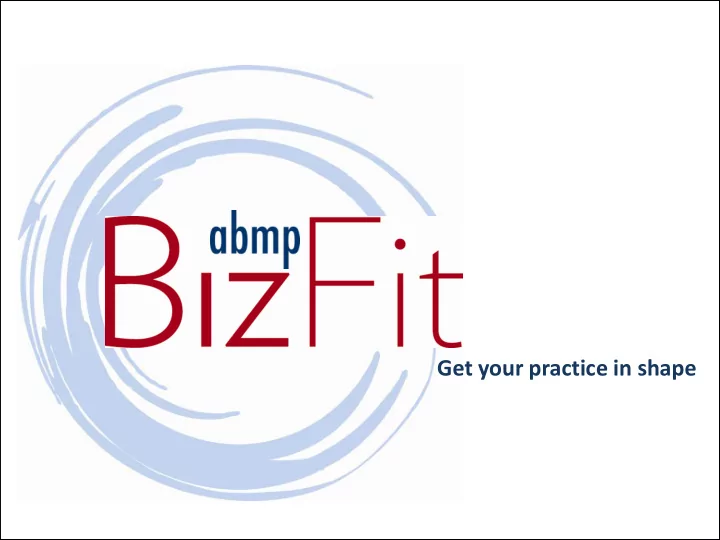

Get your practice in shape
It’s Tax Time for Massage Therapists Associated Bodywork & Massage Professionals
Anne Williams, Melanie Gourley ABMP Director of Education ABMP School Liaison
H&R Block Master Tax Advisor Jan Catron
Session Objectives Identify basic methods to keep accurate records. Discuss guidelines for tax filing. Understand allowable business deductions. Review forms for different business structures. Provide resources for tax preparation.
Taxes Defined A tax is a compulsory payment for which no specific benefit is received in return. ~ U.S. Treasury Disclaimer: Tax laws are complex and constantly changing. Each person’s tax situation is unique. This webinar is designed to provide general information about tax related information pertinent to a massage therapist.
References Preparing for Tax Time by Lisa Bakewell Massage & Bodywork Magazine IRS Publication 334, Tax Guide for Small Businesses Small Time Operator by Bernard Kamoroff Bell Springs Publishing, CA. USA Business Mastery by Cherie Sohnen-Moe Sohnen-Moe Associates, AZ. USA
Preparation for Tax Time Keep accurate records Preparing records for tax filing IRS Publication 334 Understand allowable deductions Tax Guide for Small Businesses Know which forms to file Find help when you need it
Tax Terms to Know As a small business you may be required to pay: Income tax Federal State IRS Publication 505, Tax Withholding and Estimated Tax Self-employment tax IRS Publication 15, 15A, Employment tax Employer’s Tax Guide, and Employer’s Supplemental Tax Guide Sales tax
Keep Accurate Records Overview Business checking account Recording transactions (money in / money out) Keep receipts Keep records
Business Checking Account Separate from personal account Deposit all income from massage Pay all expenses for massage business Reconcile monthly with business records
Record Transactions Record money coming in and money going out Date Payment Name Description Amount 1/23/09 Check 2189 John Doe 1 hr. Sw. M / 1 GC $120.00 1/23/09 Visa 8766 Jane Doe 90 min Sw. M $80.00 1/23/09 Visa 5678 Sue Doe Bath salts, candle, lotion $37.00 Date Payment Name Description Amount 1/23/09 Check 3221 Comcast Internet $49.00 1/23/09 Check 3222 Office Max Office supplies $92.00 1/23/09 Check 3223 M. Supply Cream, oil, disinfectant $87.00
Keep Receipts Keep every receipt Purchases Expenses Store in the same order as ledger Note missing receipts Reconcile at the end of the month
Keep Records Six years Some forever Storage Safety deposit box Fireproof filing cabinet
Prepare Records for Taxes Gross Receipts Total amount paid for massage sessions (include tips) Total amount of products sold Total amount of fees for other services Business Expenses The costs to run your business for the year
Allowable Deductions Allowable deductions include: Common business deductions Retirement savings Writing off a home office Deducting the use of a car Business expenses must be ordinary and necessary
Marketing expenses Legal services Books and magazines Rent Continuing education Loan interest Insurance and dues Credit card interest Home office Massage supplies Mileage Business related travel Laundry services Utilities Cleaning expenses Postage Bank fees Licenses / permits Equipment rental fees Accounting
Sorting Business Expenses Ordinary and necessary Personal, family, living not deductible Exception – partly business / partly personal IRS Publication 535, Business Expenses
Retirement Savings are Tax Deductible Saving for retirement = SEP IRA significant tax advantages 401k Contributions tax deductable Defined Benefit Not taxed until distributed Plan Money grows tax-free Simple IRA
Writing Off a Home Office Deduct a portion of home expenses related to business: Business part of home Mortgage interest must be used Insurance exclusively for business Utilities Must be principle part Repairs of business Depreciation
Deducting Use of a Car Deduct car expenses: Standard mileage rate Depreciation 50.5 cents per mile 1/1/08 – 6/30/08 Lease payments 58.5 cents per mile Gas and oil 7/1/08-12/31/08 Ties Repairs Divide business use from Tune-ups personal use Insurance Registration fees IRS Publication 463 (Travel, Entertainment, Gift, and Car Expenses)
Non-Deductible Expenses Business expenses not Clothing, unless it is a “ordinary and necessary” uniform used exclusively for work and unsuitable for Federal income tax and tax street wear penalties Regular commuting Fines or penalties for expenses violation of the law Some start-up expenses Payments to yourself Loan repayments Some types of club dues
Knowing Which Forms to File Sole Proprietors Partnerships and LLCs Corporations Employer’s Forms
Sole Proprietors Schedule SE: Self-Employment Tax Schedule C: Profit or Loss from Business (Sole Proprietorship) Form 1040: U.S. Individual Income Tax Return Form 1040 ES: Estimated Tax for Individuals Quarterly – if you will owe taxes
Self-Employment Tax Earnings $400 or more 15.3% 12.4% Social security 2.9% Medicare Deduct half SE tax in figuring adjusted gross income.
Schedule C – Profit or Loss from Business (Sole Proprietorship) Income Expenses Costs of Goods Sold Information on use of Vehicle
Costs of Good Sold Methods Labor Change in quantities, Materials and supplies costs, valuations Other costs Inventory beginning of Inventory at the end of the year the year Purchases
Partnerships and LLC’s Form 1065: U.S. Partnership Return of Income Form 1065 K-1: Partner’s Share of Income, Credits, Deductions, etc. Form 1040: U.S. Individual Income Tax Return
Corporations Form 1120: U.S. Corporation Income Tax Return Or short version, 1120 A Form 8109: Federal Tax Deposit Coupon Quarterly estimated tax payment
Resources for Employers Form 941: Employer’s Form 940: Employer’s Annual Quarterly Federal Tax Federal Unemployment Tax Return Return (FUTA) Form W-2: Wage and Tax Form 1099: Miscellaneous Statement Income Form W-3: Transmittal of Form 1096: Annual Summary Wage and Tax Statement and Transmittal of U.S. Information Returns
Realities of Taxes Filing date April 15, 2009 Penalties Failure to file Failure to pay Negligence Fraud
Resources: Tax Preparation Discounted tax preparation fees to ABMP members www.hrblock.com/offer s/abmp. www.irs.gov
Resources ABMP www.abmp.com Membership section BizFit Tool Kit for Tax Time Archived webinar
Summary Identified basic methods to keep accurate records. Discussed guidelines for tax filing. Reviewed allowable business deductions. Reviewed the forms for different business structures. Provided resources for tax preparation.
Questions for the H&R Block Master Tax Advisor Jan Catron
Recommend
More recommend